Android使用fragment实现底部导航栏切换界面
Posted
tags:
篇首语:本文由小常识网(cha138.com)小编为大家整理,主要介绍了Android使用fragment实现底部导航栏切换界面相关的知识,希望对你有一定的参考价值。
参考技术A 源码链接效果图
创建bottom_layout.xml
<?xml version="1.0" encoding="utf-8"?>
<LinearLayout xmlns:android="http://schemas.android.com/apk/res/android"
android:layout_width="match_parent"
android:layout_height="match_parent"
android:orientation="vertical"
android:gravity="center">
<ImageView
android:layout_width="36dp"
android:layout_height="36dp"
android:id="@+id/bottom_icon"
/>
<TextView
android:layout_width="wrap_content"
android:layout_height="wrap_content"
android:textColor="#565656"
android:textSize="10sp"
android:id="@+id/bottom_text" />
public void setNormalImage(int normalIcon)
this.normalIcon = normalIcon;
ivIcon.setImageResource(normalIcon);
public void setFocusedImage(int focusedIcon)
this.focusedIcon = focusedIcon;
public void setTvText(String text)
tvText.setText(text);
public void setFocused(boolean isFocused)
this.isFocused = isFocused;
if(isFocused)
ivIcon.setImageResource(focusedIcon);
tvText.setTextColor(Color.parseColor("#02b5bc"));
else
ivIcon.setImageResource(normalIcon);
tvText.setTextColor(Color.BLACK);
<FrameLayout
android:id="@+id/frameLayout_container"
android:layout_width="match_parent"
android:layout_height="0dp"
android:layout_weight="11"
>
</FrameLayout>
四个如下
<com.example.qiaolulu.qiaofragment.BottomLayout
android:id="@+id/square"
android:layout_width="0dp"
android:layout_height="wrap_content"
android:layout_weight="1">
</com.example.qiaolulu.qiaofragment.BottomLayout>
public class Babyextends Fragment
@Nullable
@Override
public ViewonCreateView(@NonNull LayoutInflater inflater, @Nullable ViewGroup container, @Nullable Bundle savedInstanceState)
//加载你设计要显示的界面
View view = inflater.inflate(R.layout.baby,null);
return view;
fragmentManager = getSupportFragmentManager();
FragmentTransaction transaction =fragmentManager.beginTransaction();
firstPage =new FirstPage();
transaction.add(R.id.frameLayout_container,firstPage);
transaction.commit();
Android开发----生成Android底部导航栏
Android利用android studio自动生成底部导航栏
使用Bottom Navigation Activity+Fragment+ViewPager实现底部导航栏
文章目录
1.新建项目,选择Bottom Navigation Activity
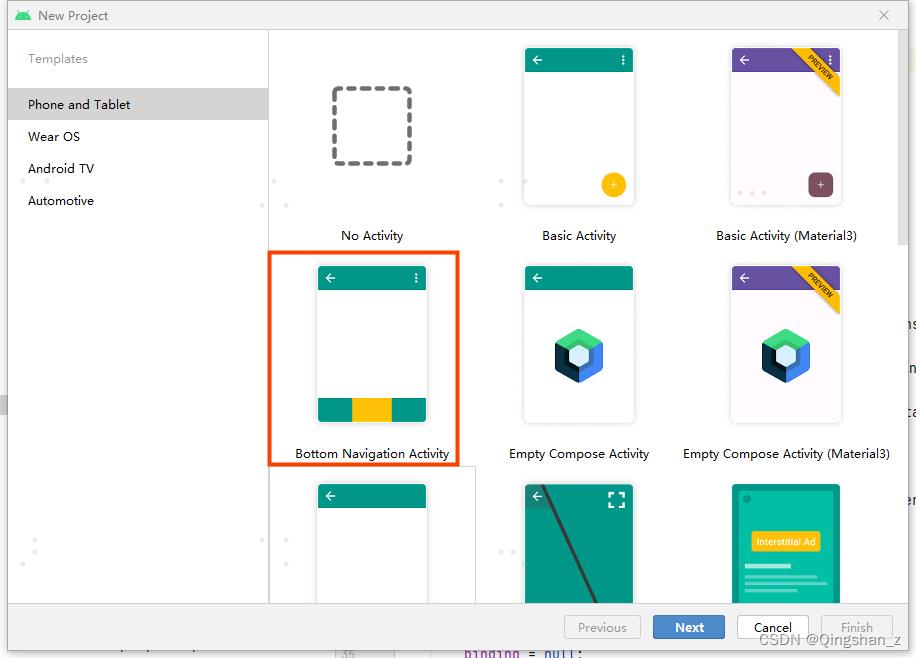
自动生成的底部导航栏如下图所示:

自动生成的文件结构如下图所示。
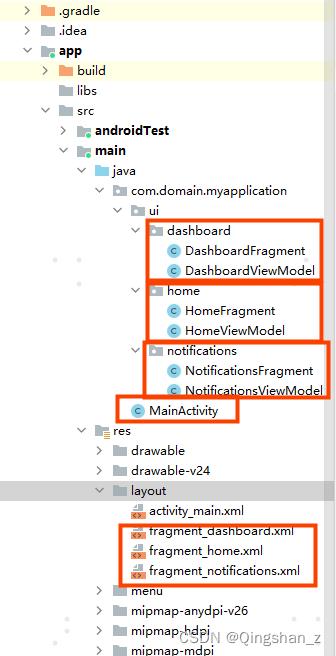
2.更改底部导航栏名字
底部导航栏的名字用的事string资源,直接在[values]-[strings]中更改需要的string资源,我这里是用了4个fragment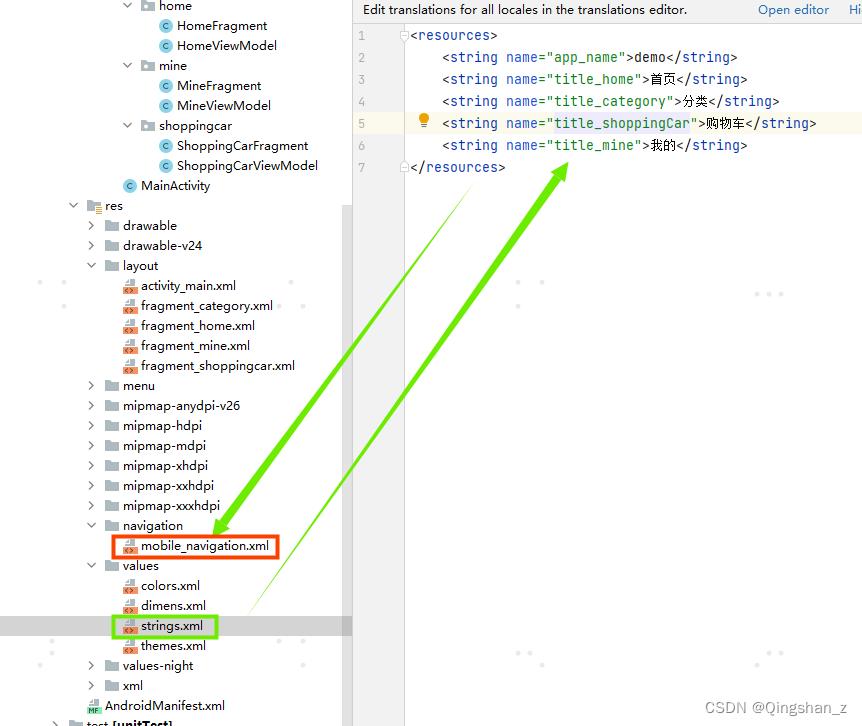
然后去底部导航栏资源[navigation]-[mobile_navigation]中更改调用的字符串资源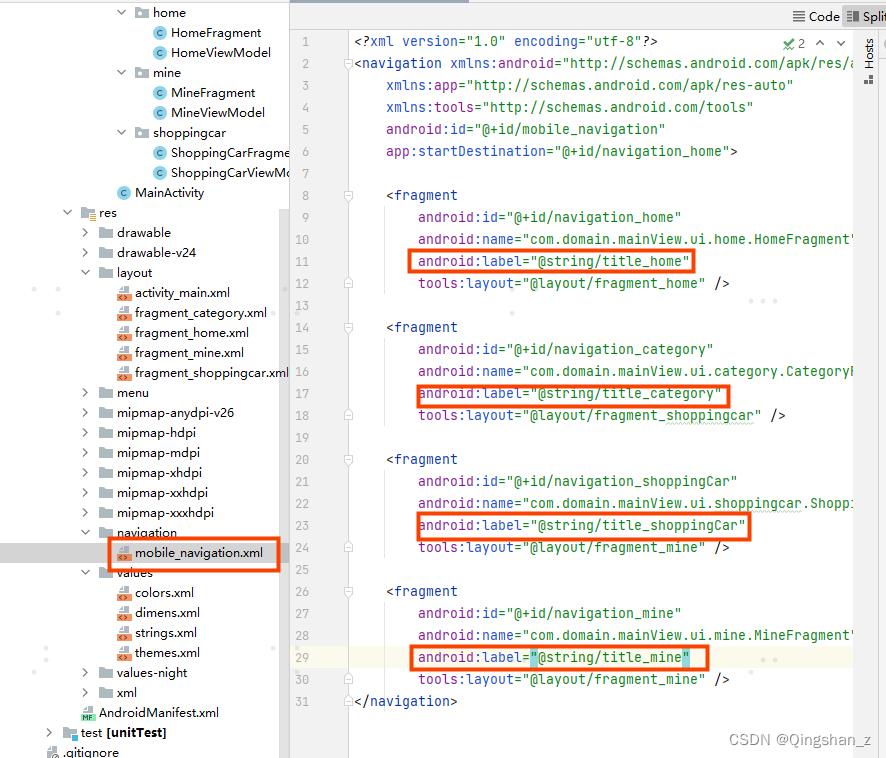
3.更改底部导航栏图标
1)我用的是android studio自动生成的图标
在[drawable]资源中,右键–new–Vector Asset
2)点击下图中的图标,进行图标的选择。(这部分我看过很多资料说也可以自己在xml文件的pathData自己画图标,也可以自己添加png格式的图标。)

删除原有图标,并按照上述步骤创建好自己需要的所有图标。(一般不超过5个)
3)剩下的就是要更改包名、类名、fragment资源名,以及调用的路径名。注意下面几个文件。改全就好。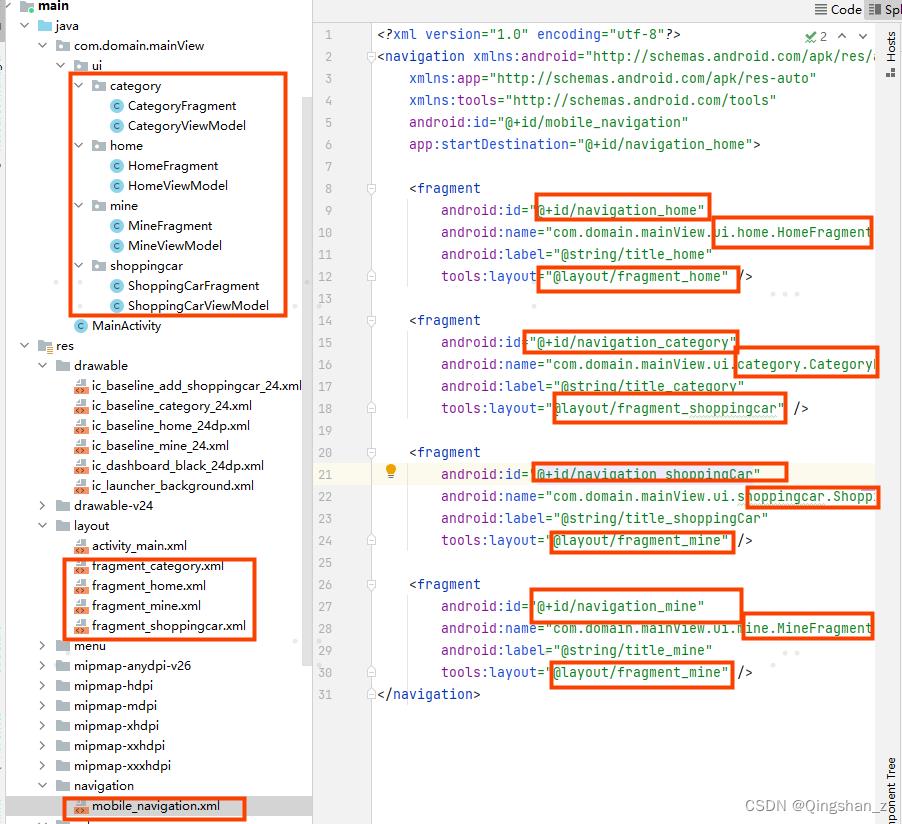
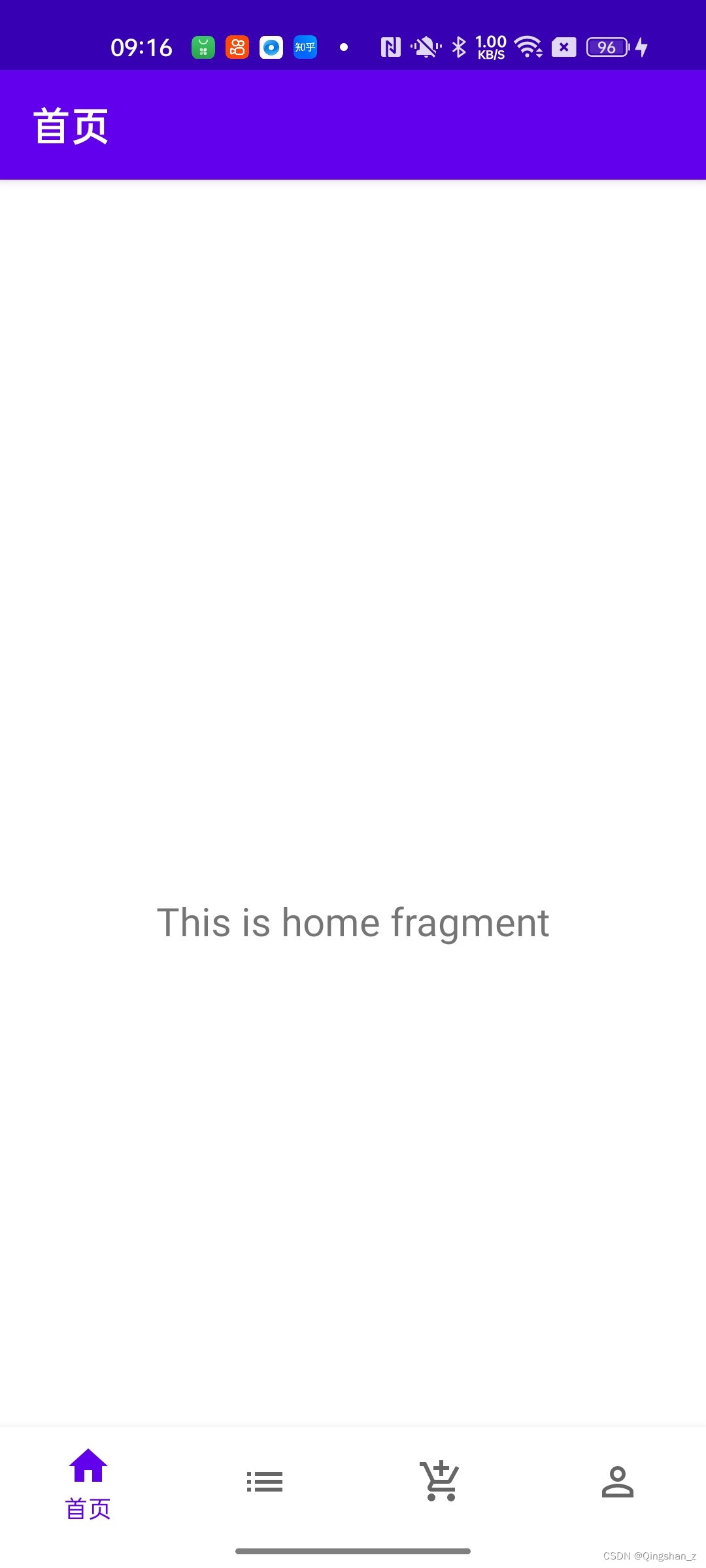

4.更改主题颜色
colorPrimary是主图颜色
colorPrimaryVariant是顶部摄像头那行所在状态栏的颜色

如下图所示
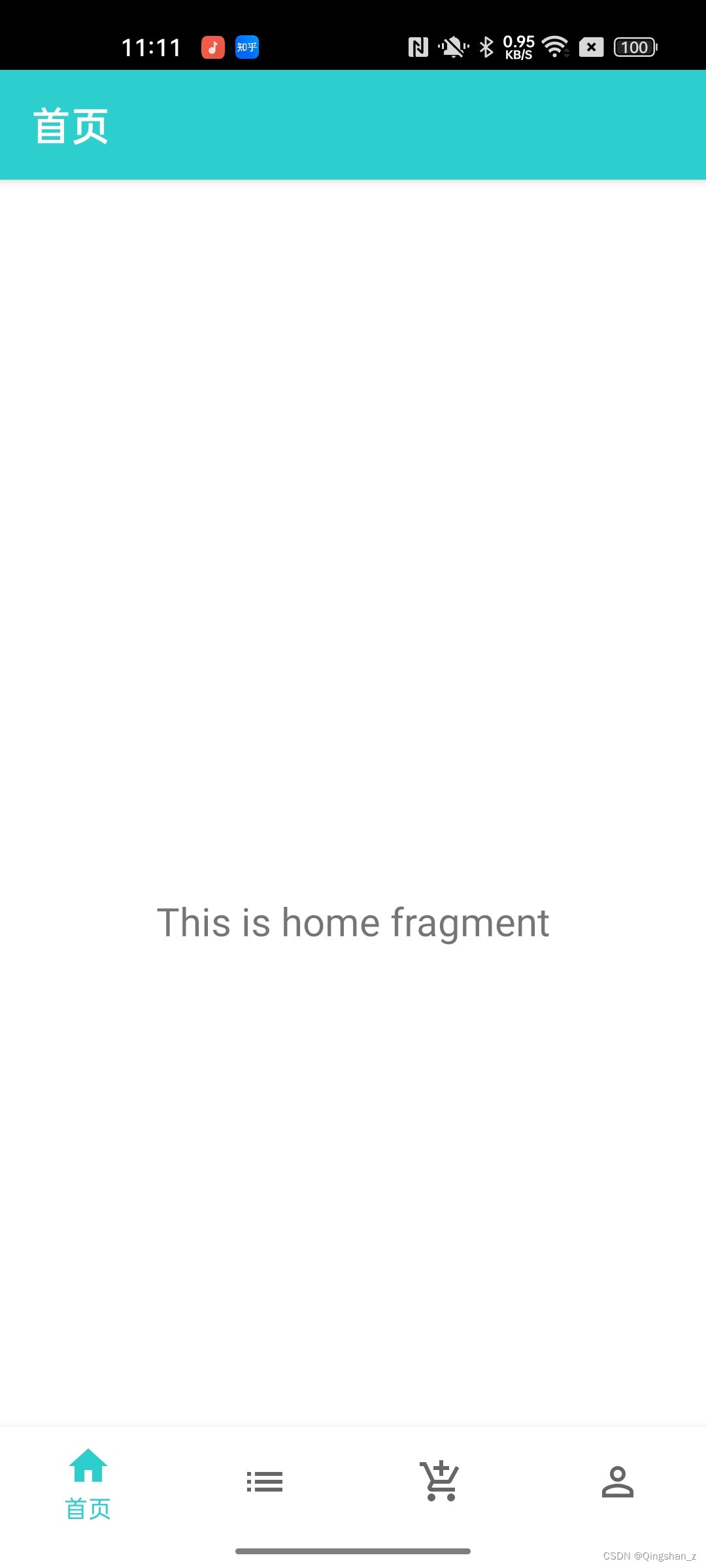
5.分析自动生成的MainActivity.xml的布局方式ConstrainLayout布局
生成的底部导航栏和Fragment使用的都是ConstrainLayout布局
<?xml version="1.0" encoding="utf-8"?>
<androidx.constraintlayout.widget.ConstraintLayout xmlns:android="http://schemas.android.com/apk/res/android"
xmlns:app="http://schemas.android.com/apk/res-auto"
android:id="@+id/container"
android:layout_width="match_parent"
android:layout_height="match_parent"
android:paddingTop="?attr/actionBarSize">
<!--底部导航栏-->
<com.google.android.material.bottomnavigation.BottomNavigationView
android:id="@+id/nav_view"
android:layout_width="0dp"
android:layout_height="wrap_content"
android:background="?android:attr/windowBackground"
app:layout_constraintBottom_toBottomOf="parent"
app:layout_constraintHorizontal_bias="0.0"
app:layout_constraintLeft_toLeftOf="parent"
app:layout_constraintRight_toRightOf="parent"
app:menu="@menu/bottom_nav_menu" />
<!-- 在这里调整fragment的布局 -->
<fragment
android:id="@+id/nav_host_fragment_activity_main"
android:name="androidx.navigation.fragment.NavHostFragment"
android:layout_width="match_parent"
android:layout_height="match_parent"
app:defaultNavHost="true"
app:layout_constraintBottom_toTopOf="@id/nav_view"
app:layout_constraintHorizontal_bias="1.0"
app:layout_constraintLeft_toLeftOf="parent"
app:layout_constraintRight_toRightOf="parent"
app:layout_constraintTop_toTopOf="parent"
app:layout_constraintVertical_bias="1.0"
app:navGraph="@navigation/mobile_navigation" />
</androidx.constraintlayout.widget.ConstraintLayout>
<!-- 基本方向约束 -->
<!-- 我的什么位置在谁的什么位置 -->
app:layout_constraintTop_toTopOf="" 我的顶部和谁的顶部对齐
app:layout_constraintBottom_toBottomOf="" 我的底部和谁的底部对齐
app:layout_constraintLeft_toLeftOf="" 我的左边和谁的左边对齐
app:layout_constraintRight_toRightOf="" 我的右边和谁的右边对齐
app:layout_constraintStart_toStartOf="" 我的开始位置和谁的开始位置对齐
app:layout_constraintEnd_toEndOf="" 我的结束位置和谁的结束位置对齐
app:layout_constraintTop_toBottomOf="" 我的顶部位置在谁的底部位置
app:layout_constraintStart_toEndOf="" 我的开始位置在谁的结束为止
<!-- ...以此类推 -->
以上是关于Android使用fragment实现底部导航栏切换界面的主要内容,如果未能解决你的问题,请参考以下文章